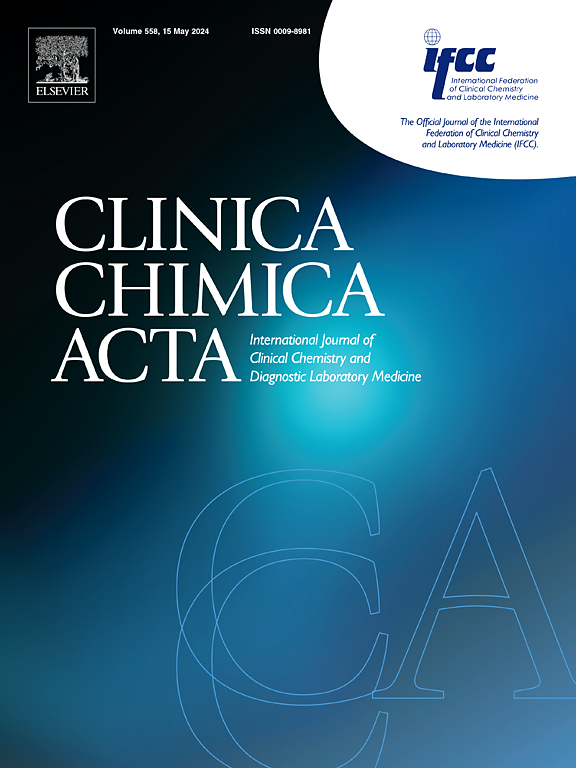Advances in prognostic and predictive biomarkers for breast cancer: Integrating multigene assays, hormone receptors, and emerging circulating biomarkers
IF 2.9
3区 医学
Q2 MEDICAL LABORATORY TECHNOLOGY
引用次数: 0
Abstract
Breast cancer is a biologically diverse disease, and optimizing patient outcomes requires precise prognostic and predictive tools to guide treatment decisions. Over the past two decades, significant advances have been made in stratifying breast cancer risk through the integration of multigene assays, hormone receptor profiling, and emerging circulating biomarkers. This review outlines the current landscape and future direction of prognostic and predictive biomarker development. Combining specific multigene tests, biomarkers such as HER2/neu, and traditional clinicopathological prognostic factors is the most efficient way to determine prognosis. Well-established multigene assays such as Oncotype DX, MammaPrint, and uPA/PAI-1 are routinely employed to inform adjuvant treatment decisions in hormone receptor-positive, HER2-negative subtypes. Hormone receptor status (ER, PR) and HER2 expression continue to serve as cornerstone predictors of therapeutic response to endocrine and anti-HER2 therapies. Concurrently, a new generation of non-invasive biomarkers like circulating tumor DNA (ctDNA), microRNAs, and circulating tumor cells (CTCs) offers promise for real-time monitoring of treatment response and early detection of resistance, particularly in advanced disease. Notably, ESR1 mutations detected in ctDNA have emerged as potential indicators of resistance to aromatase inhibitors. Despite these advances, the identification of robust biomarkers to predict response to chemotherapy and radiotherapy remains a critical unmet need. This review synthesizes current evidence and highlights key challenges and opportunities in the clinical translation of biomarker-driven precision oncology for breast cancer.

乳腺癌预后和预测生物标志物的进展:整合多基因检测、激素受体和新兴的循环生物标志物。
乳腺癌是一种生物多样性疾病,优化患者预后需要精确的预后和预测工具来指导治疗决策。在过去的二十年中,通过整合多基因检测、激素受体谱分析和新兴的循环生物标志物,在乳腺癌风险分层方面取得了重大进展。本文概述了预后和预测性生物标志物发展的现状和未来方向。结合特异性多基因检测、生物标志物如HER2/neu和传统的临床病理预后因素是确定预后的最有效方法。成熟的多基因检测,如Oncotype DX、MammaPrint和uPA/PAI-1,通常用于激素受体阳性、her2阴性亚型的辅助治疗决策。激素受体状态(ER, PR)和HER2表达继续作为内分泌和抗HER2治疗反应的基础预测因子。同时,新一代非侵入性生物标志物,如循环肿瘤DNA (ctDNA)、microrna和循环肿瘤细胞(CTCs),为实时监测治疗反应和早期发现耐药性提供了希望,特别是在晚期疾病中。值得注意的是,在ctDNA中检测到的ESR1突变已成为对芳香酶抑制剂耐药的潜在指标。尽管取得了这些进展,但确定可靠的生物标志物来预测化疗和放疗的反应仍然是一个关键的未满足需求。这篇综述综合了目前的证据,并强调了生物标志物驱动的乳腺癌精确肿瘤学临床转化中的关键挑战和机遇。
本文章由计算机程序翻译,如有差异,请以英文原文为准。
求助全文
约1分钟内获得全文
求助全文
来源期刊

Clinica Chimica Acta
医学-医学实验技术
CiteScore
10.10
自引率
2.00%
发文量
1268
审稿时长
23 days
期刊介绍:
The Official Journal of the International Federation of Clinical Chemistry and Laboratory Medicine (IFCC)
Clinica Chimica Acta is a high-quality journal which publishes original Research Communications in the field of clinical chemistry and laboratory medicine, defined as the diagnostic application of chemistry, biochemistry, immunochemistry, biochemical aspects of hematology, toxicology, and molecular biology to the study of human disease in body fluids and cells.
The objective of the journal is to publish novel information leading to a better understanding of biological mechanisms of human diseases, their prevention, diagnosis, and patient management. Reports of an applied clinical character are also welcome. Papers concerned with normal metabolic processes or with constituents of normal cells or body fluids, such as reports of experimental or clinical studies in animals, are only considered when they are clearly and directly relevant to human disease. Evaluation of commercial products have a low priority for publication, unless they are novel or represent a technological breakthrough. Studies dealing with effects of drugs and natural products and studies dealing with the redox status in various diseases are not within the journal''s scope. Development and evaluation of novel analytical methodologies where applicable to diagnostic clinical chemistry and laboratory medicine, including point-of-care testing, and topics on laboratory management and informatics will also be considered. Studies focused on emerging diagnostic technologies and (big) data analysis procedures including digitalization, mobile Health, and artificial Intelligence applied to Laboratory Medicine are also of interest.
 求助内容:
求助内容: 应助结果提醒方式:
应助结果提醒方式:


